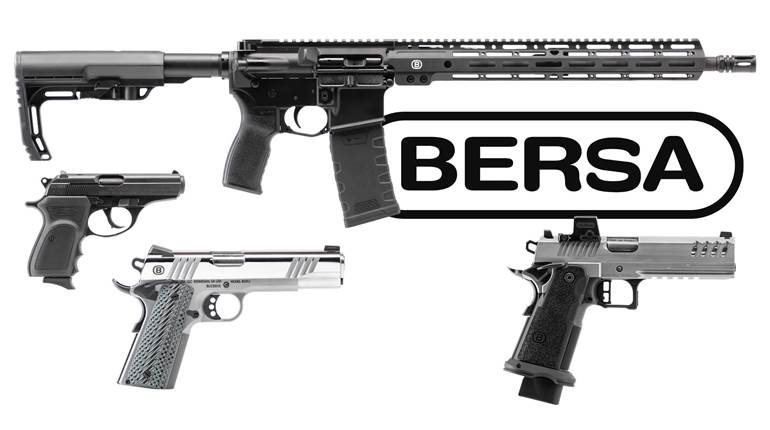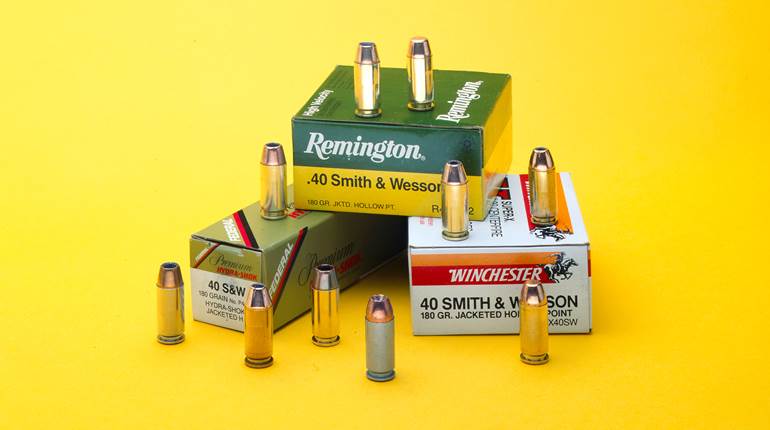
In search of a high-tech semi-automatic for concealed carry? There’s no better time to do it, since the pistol industry is fiercely competitive, offering a wide variety of models for every conceivable need. Guns from the major makers come in several chamberings and a variety of operating systems, but today’s design trends involve reduced size and weight. It is also true that the makers work to develop less costly ways to build their products. A lower price point is very appealing when the buyer has a selection of guns laid out on the counter mats of a local gun shop; however, if you look back at what has been tabbed as “new” during the past few years, it has been the size and weight of the guns that so often closes the deal. It seems everybody wants as many shots as possible, as well as some form of safe and simple trigger action, but they want it in an ever-decreasing mass.
It is exactly this criterion that influenced SIG Sauer to develop a new pistol called the P224. A chunky, little recoil-operated semi-automatic, the P224 bears a strong family resemblance to other pistols in the company’s distinguished P-series line. It is a small gun, but not one to be confused with the personal-size, ultra-compact or micro-size pistols that we have heard so much about in the last few years. These skinny-nines are invariably very flat because they have single-column magazines to go with short barrel and butt dimensions. Not so with the P224, which retains its predecessors’ double-stack magazine design in order to fulfill the service pistol role in as small a package as possible. It does that quite well, as well as maintaining the SIG Sauer line’s recognizable features and operational characteristics.
SIG Sauer pistols have existed since the early 1970s as a result of the joint efforts of Swiss and German firms. In the pre-World War II era, the German firm of J.P. Sauer & Sohn made a much-respected pocket pistol called the Sauer 38H, while Schweizerische Industrie Gesellschaft (SIG) of Switzerland later developed a superb service pistol called the P210. Between them, the two companies brought great design and manufacturing experience to the development of a line of pistols. Made in Germany at the Eckenforde plant, the guns have been widely popular in the United States since first imported here in the 1970s. It is interesting to note that in the past 40 years, SIG Sauer pistols have evolved logically, but remain fundamentally the same gun as initially sold in the Nixon years. Many competing designs cannot make that claim. Plainly, they got it right from the start.
What they got right was a series of semi-automatic pistols with several significant innovations. Initially, the guns came with a machined receiver and unique sheet steel slide. As much as some critics were concerned with the strength of these units, they have an excellent track record in hard service. The development of such cartridges as the .40 S&W and .357 SIG eventually required a machined steel slide, and all SIG pistols now have that feature. Early on, SIG Sauers differed from the rest of the pack in that they locked up in a much different way. Instead of barrel locking lugs being cammed into recesses in the slide, a square breech end of the barrel fitted into a square ejection port. Many other brands now have this feature. Since those early guns came along at a time when double-action/single-action trigger systems were just being accepted in police service, SIG engineers developed an unusual—but very sensible—arrangement. With the hammer down, the first-shot is fired double-action, with the trigger cocking and then releasing the hammer to fire. Subsequent shots are single-action, and there is no manual safety. There is no real need for one on a pistol that is carried hammer down in the same way as a revolver.
The SIG system did include a logically placed decocking lever just above the left grip panel. This is the basic formula for the P-series of pistols that have done so well for nearly 40 years. In recent times, the innovators in SIG Sauer’s engineering department have added a unique, optional double-action-only trigger system known as the “DAK” trigger. The designation is for “double-action, Kellerman” (the latter for the system’s designer), and it gives the shooter a short, smooth factory-rated pull of about 7 pounds, 8 ounces, for every shot. All of the four versions of the P224—the SAS, or SIG Anti-Snag, the Equinox, the Nickel and the Extreme reviewed here—offer the DAK trigger, but the DA/SA Short Reset Trigger is available on the SAS, and the Extreme and the standard DA/SA system is available on the Equinox and Nickel.
SIG Sauer has focused considerable attention on making its pistols more useful to a wider variety of handgunners. That means going after the growing civilian concealed-carry market. It’s one thing to carry a hefty pistol in a strong-side holster on a wide belt. Most of us outside of law enforcement don’t live and work where this is possible, so our carrying is licensed concealed carry, which is another thing entirely. Full-size pistols can sometimes be hidden under casual or business-type clothing, but most handgunners simply want a smaller, lighter, generally more compact handgun. Meeting this trend is a major design influence, and the subject handgun, SIG Sauer’s P224, is a perfect example of the concept at work.
The P224 is available in three chamberings used in both full-size and compact pistols—9 mm Luger, .357 SIG, .40 S&W. Originally, the P226 was a pistol intended for the U.S. service pistol trials. A full-size gun in 9 mm Luger, it was widely used in American law enforcement. Several years later, SIG Sauer came out with a reduced-size gun known as the P228 and, eventually, the P229. The latter was necessary for use with the .357 SIG and .40 S&W cartridges. These two models have been erroneously described as scaled-down versions of the P226. They are better described as abbreviated or shortened versions of the parent gun. The P224 is simply an even shorter version of the P229 and P226 pistols.
SIG Sauer is currently running an ad campaign showing a new P224 lying on a workbench. Adjacent to the muzzle and to the butt, there are the sawed-off sections of a P229. Let there be no confusion, SIG Sauer does not make P224s by literally cutting sections off of P229s. The graphic ad simply demonstrates how much smaller the gun actually is. Specifically, let’s look at some measured comparisons. The P224 measures 6.7-inches long by 4.5-inches high by 1.5-inches thick, while the parent P229 is 7.1x5.4x1.3 inches.
The basic magazine for each of the three models has a different length and a floorplate that is roughly flush with the bottom of the steel tube. The flush-fitting short magazine holds 10 rounds of .40 S&W, and the longer P229-type with bottom collar takes 12. It is possible to use the longer magazines in the shorter guns. With that in mind, SIG Sauer sent the sample pistol, with a P224 and a P229 magazine, and the latter had a collar around its base that filled out the butt to about the same shape as a P229 pistol. Either a P226 or P229 magazine will fit into and function in the short-butt P224. I tried all three types in my sample P224 with no problems. For daily carry, the short magazine would be more easily concealable; but more shots on tap might be a good idea when trouble is on the way, so the longer magazines could be carried as spares. For shooting, the longer magazine is superior in that there is far more gun to hold.
The gray Hogue Extreme G10 stocks are finished with a modernistic checkering pattern. Controls are the same as found on other P-series pistols. Since the sample came with the Kellerman trigger option, there was no decocking lever in place, but the slide lock, magazine catch and takedown lever are on the left side of the gun. Sights fit into dovetails in the top of the slide and feature a system of three-dot tritium highlights. The Extreme’s finish was an all-business dull black.
A pistol with such a serious appearance fairly begs to be shot, so I packed up my truck with targets, ammo and related gear and headed for the range. On the way I reflected on the fact that one of my first assignments as a full-time staff writer was a SIG pistol survey, during which I developed a healthy respect for their accuracy. But because I began this evaluation before the P224 was formally introduced, I knew that Ransom Rest inserts were not available. I tried to improvise, but was unable to so do. This partly explains the lack of typical SIG Sauer accuracy. In short, I believe the new P224 would do a great deal better when properly machine rested.
In the hand, the P224 is a solid fistful of gun. It is rather full in the well-shaped butt section, but surprisingly heavy. It proved to be rather tough to manage, particularly with the short magazine in place. I could get only two fingers on the frontstrap, and the pistol felt as though it was attempting to twist right out of my hand on firing. Recoil is a problem in a pistol with such a short grip. Functioning was 100 percent in more than 200 rounds downrange.
The P224 is a solid, rather heavy, high-capacity pistol in today’s more popular calibers. It is small enough to conceal under most clothing and packs a big punch with 11 (or 13) rounds of .40 S&W or .357 SIG on tap. It’s obvious that the P224 has all the virtues of the company line—accuracy, dependability and an operating system that is a delight to use. Most important, it is smaller and more easily hidden than its stablemates, an important feature in today’s uncertain world.
Manufacturer: SIG Sauer; (603) 772-2302; www.sigarms.com
Caliber: 9 mm Luger, .357 SIG, .40 S&W (tested)
Action Type: recoil-operated semi-automatic, center-fire pistol
Frame: aluminum alloy
Barrel: 31⁄2"
Rifling: six-groove, 1:16" RH twist
Magazine: 10-round-capacity detachable box (12 round available)
Sights: drift adjustable for windage front and rear, square notch with tritium dots (others available)
Trigger: double-action-only DAK (tested) 6-lb., 8-oz. pull; DA/SA or DA/SA Short Reset Trigger available
Overall Length: 6.7"
Width: 1.3"
Height: 41⁄2"
Weight: 25 ozs.
Accessories: spare magazine, lockable case, owner’s manual
Suggested Retail Price: $ 1,125






































